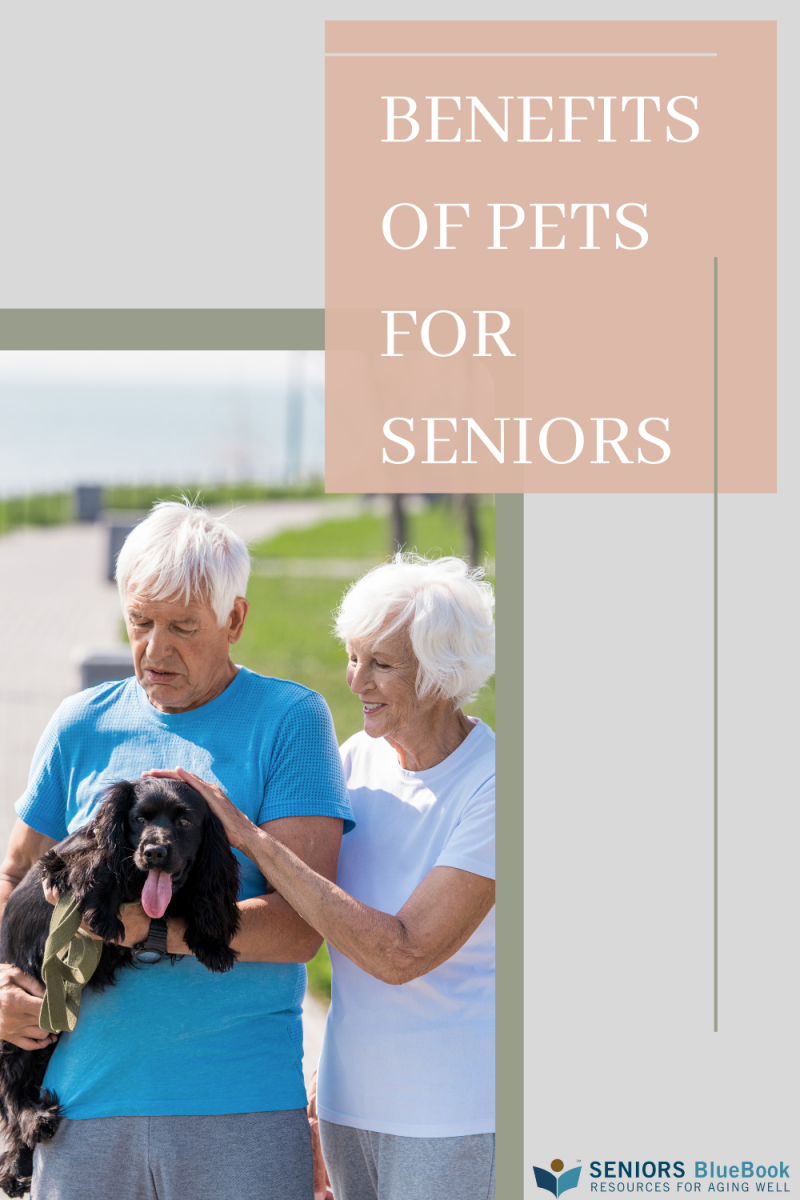Benefits of Pets for Seniors
The Gallery at Cape Coral
For more information about the author, click to view their website: The Gallery at Cape Coral
Feb 04, 2022
Florida - Southwest
Email US
Click to Email Us
The old saying goes that a dog is a mans best friend, but pets of all types can fill our hearts and fill our days with purpose and joy. If you consider adopting a pet as a senior, you can experience rich emotional rewards and multiple health benefits.
MENTAL HEALTH BENEFITS OF OWNING A DOG
Opening your home to a dog or cat can lead to multiple mental health benefits leading to a happier disposition, stronger social bonds, and deeper enjoyment of life.
Social Interaction
The transition to an empty-nester can lead to loneliness and other unpleasant feelings. Adopting a pet boosts your social interaction in two distinct ways. You always have your furry friend close by to share life's joys and challenges. Plus, you can meet other pet owners while walking your pet, going to the vet, taking Bongo to the groomer, or simply heading to a dog park. You can build lasting bonds with fellow pet owners and find a supportive community.
Creating Purpose
There's no idly sitting in a chair and watching the day go by when Fifi needs consistent care. Pets help you create a routine and live each day with purpose. Pets help seniors build a daily schedule around feedings, walks, trips to the bathroom, playtime, and bedtime.
Constant Companionship
Life is always more rewarding when shared with others, and that adage is just as true about our canine and feline companions. A 2017 study published in the journal Acta Bio Medica concluded that interacting with a household pet increased the quality of life and reduced feelings of loneliness and apathy regarding pet therapy and the elderly, especially for patients with dementia or mental illness.
PHYSICAL HEALTH BENEFITS OF OWNING A PET
In addition to the companionship owning a pet offers, living with your favorite furry pal promotes tangible health benefits that can have a long-lasting impact on your physical well-being.
Encourages Daily Exercise
Most people can attest that its easy to be a couch potato with the lure of the TV or browsing the internet, but owning a pet is a great motivation to get up and move. While Fido scratches at the door for a walk, you reap the benefits of sunshine, increasing your heart rate, and exercising your mobility. Incorporating a walk with your pup into your daily routine can improve your cardiovascular health and promote daily movement.
Boost Motor Skills
Owning a pet is an interactive endeavor. While you're brushing your cats hair or preparing her favorite breakfast treat, you'll also be working on bilateral integration and eye-hand movement. The little tasks that fill you with love like nighttime head scratches keep your joints lubricated and your coordination sharp.
'
BEST PETS FOR SENIORS
If you decide to adopt a pup, try to stick with smaller breeds that aren't as physically active. Ideal dogs for seniors are smaller breeds that are well-suited for apartment living. You might consider:
Maltese Maltese are small but stalwart lap dogs. However, they do require regular grooming.
Shih Tzu Shih Tzus are also lovable, pint-sized, and a good match for seniors. They also require consistent grooming.
Cavalier King Charles Spaniel Cavaliers are typically quiet, affectionate, and, as a bonus, don't require as much grooming compared to other small breeds.
Short-haired cats are terrific companion pets for seniors who cant commit to daily walks. Cats clean themselves, are quieter than dogs, and are more independent. Consider adopting a cat if you want a companion with minimal maintenance.
ASSISTED LIVING THAT ALLOWS DOGS AND CATS
Some seniors who have four-legged best friends may hesitate to commit to Assisted Living. After all, in some senior retirement communities, pets aren't allowed on the premises.
Other Articles You May Like
Naples Clinic Expands to Provide Free Medications for Low-Income Workers
For low-income Collier County residents who are working but uninsured, access to the medications they need is not as easy as going to a regular chain pharmacy to pick them up. Thats where the Neighborhood Health Clinics expanded non-narcotic medication room comes in, giving patients managing chronic conditions including hypertension and diabetes timely access to medications at no cost. The 1,850-square-foot medication room, located at the clinic on Goodlette-Frank Road near Central Avenue, was built at a cost of $500,000 and is named for the late Stacy Forman, a Naples philanthropist who donated funding for the expansion.Keith Maples, CEO of Neighborhood Health Clinic, said the expanded medications facility enhances the clinics ability to serve patients faster and more efficiently. On a typical day, a patient can walk in and when they walk out, theyre walking out with thousands of dollars worth of medication that, if it were outside of the Clinic, they would not be able to fill those prescriptions because it would be outside of what they could afford, Maples said. He said the expanded space, equipped with updated technology and increased storage capacity, allows for a larger inventory of non-narcotic medications that enables the Clinic to fill prescriptions immediately to minimize delays in treatment. In 2024, the Clinic distributed $6.5 million in retail value of medications thanks to partnerships with Americares, Direct Relief, Dispensary of Hope and other pharmaceutical companies. The expansion allows us to work even more with our pharmaceutical partners to basically procure all of the medications necessary for our patients, Maples said. He said that many patients arriving at the Clinic for the first time have not previously received medical care for the condition needing treatment and may have vastly elevated blood pressure or blood sugar levels, for example. When they walk through the doors, theyre at such a heightened level that were trying to bring it back to a controlled number to where its manageable for them, Maples said. If their A1Cs are through the roof, their [blood] sugars are through the roof, were trying to get them back to an established number that helps them feel better. Well never cure them of all those illnesses, but well maintain that health for them, so they feel better and have a better quality of life.Clinic grows to meet patient demand The nonprofit Neighborhood Health Clinic was established in 1999 by Dr. Bill and Nancy Lascheid to provide medical care to low-income, working but uninsured Collier County adults. Their daughter, Leslie Lascheid, now serves as president of the organization. In 2024 the clinic saw more than 12,000 patient visits and delivered more than 30,000 patient procedures, Maples said, with all medications, primary care, specialty care, surgeries and outpatient procedures provided free of charge to patients.All funding is through philanthropy, as the Clinic does not receive any city, county, state or federal funding including Medicaid or Medicare. Over the years the clinic has expanded as the patient load has increased. The original 11,000-square-foot facility more than doubled in size with the completion of the Armstrong Medical Specialties Building in 2021, which expanded the campus to 23,000 square feet. The addition of the Van Domelen Education and Wellness Building, also in 2021, took the total to its current 32,000 square feet, and when the Bill and Candy Raveis Pathology Building is completed this summer, the total campus will be at 43,000 square feet, according to Marcie Berland, the Clinics director of development. Maples said the Clinic has expanded strategically over the years to meet the medical needs of patients many of whom work in hospitality, service or construction industries in Collier County and the growing volume of patient visits. When weve expanded, we didnt do it just to do it, he said. We based it on what were the patient needs and what do we need in-house on a daily basis to deliver the care, providing the opportunity for a patient to walk in the door, get all the care they need and not have to go to another location somewhere else, or come for another appointment. Because when our patients miss days of work, thats food on the table and the roof over their heads. Its not like if I call in sick: I get a sick day and still get paid. He said the campus expansions allow most procedures including lab work to be done in-house, creating opportunities for sustainable, uninterrupted patient care. When that patient walks through the doors, I never want them to wonder where theyre going to get their care or how theyre getting to their next appointment, Maples said. Many of our patients get rides here, or they walk or ride their bikes, because very few own cars that they can drive in. And while the Clinic does have a full-time paid staff of 14 and five part-time staff, no medical professionals are paid to deliver care, Maples said. More than 250 physicians, 50 dentists, 100 nurses and 300 non-medical personnel deliver care and provide patient education on a volunteer basis.
Beyond the Surface: Naples Cancer Advisors Spotlight Melanoma During Awareness Month
Beyond the Surface: Naples Cancer Advisors Spotlight Melanoma During Awareness MonthMay 1, 20256 Min ReadBy Jillian Hunt, CNP Executive Director of Clinical Operations at Naples Cancer AdvisorsMay is Melanoma Awareness Month, and in sun-drenched Collier and Lee Counties, its more than a calendar observance. Its a call to action. The sunny environment increases exposure to ultraviolet (UV) rays, which are a significant risk factor for skin cancer, including melanoma. Understanding the risks and adopting preventive measures can help residents enjoy the sun safely while minimizing their skin cancer risk.At NCA, we specialize in delivering second opinions and expert oncology guidance at no cost to patients. Our team, including nationally recognized oncologist Dr. Philip Leming, believes that no one should face a cancer diagnosis alone. This month, we want to shine a light on reshaping melanoma prevention, detection, and awarenessso you can stay protected and proactive.Prevention: A Daily Practice, Not Just a Summer ChecklistMost people know the basics: use sunscreen, avoid tanning beds, cover up when outside. But melanoma doesnt just show up where the sun shines. It can develop under your fingernails, between your toes, even on your scalp or eyes. We educate patients to look everywhere, not just the obvious spots.One powerful (and often overlooked) fact: a single blistering sunburn in childhood doubles your lifetime risk of melanoma. Thats why prevention is a family affair. We urge parents to build sun safety habits early and keep them consistent all year.Detection: A Watchful Eye is The Best ToolThe front line of defense against skin cancer is early detection. Identifying skin changes especially changes in moles is the easiest way to catch skin cancer earlier.What is a mole?A mole is a benign (non-cancerous) growth on the skin that develops when melanocytes, the cells responsible for producing pigment, cluster together instead of being evenly distributed. Moles can be present from birth or develop later in life.ABCDEs of Moles and Melanoma Detection Asymmetry: One half of the mole doesnt match the other. Border irregularity: The edges of the mole are uneven, ragged, or notched. Color variation: The mole has multiple shades of brown, black, or other colors like red, white, or blue. Diameter: The mole is larger than 6 millimeters (about the size of a pencil eraser). Evolving: The mole has changed in size, shape, or color, or has new symptoms like itching, bleeding, or crusting.The ABCDEs are a helpful tool for self-examination and can prompt individuals to seek professional medical advice if any of these signs are present.Dermatologists remain the front line in detection and diagnosis. However, emerging technologies are offering exciting backup. Artificial intelligence skin scanners and total body imaging are improving the speed and accuracy of diagnosis.Whether its through advanced tools or a trained eye, one truth remains: catching melanoma early saves lives.The NCA Difference: Compassionate, Cost-Free Cancer GuidanceNaples Cancer Advisors was founded to be a bridge for patients who feel lost, overwhelmed, or unsure where to turn after a cancer diagnosis. We offer a second set of expert eyes, help explain treatment options, connect people to top-tier providers, and support them throughout their journey.Melanoma may be aggressive, but its also highly preventable and treatable when caught early. This May, we urge everyone in our community to schedule a skin check, learn your ABCDEs (Asymmetry, Border, Color, Diameter, Evolving), and take sun safety seriously.And if you ever need clarity or support after a diagnosis, Naples Cancer Advisors is herefree, local, and fully focused on you.Jillian Hunt, CNP BioJillian has been caring for cancer patients since 2004. In that time, she has set the benchmark for her patient-centric approach in Cincinnati, Southwest Florida, and beyond.Her professional journey began at Cincinnati Childrens Hospital Medical Center in 1999 on the hematology/oncology/bone marrow transplant unit and later the emergency department.After spending five years caring for children, Jillian found her passion in caring for the adult oncology patient. Starting as a chemotherapy infusion nurse in private practice with Dr. Philip Leming at Cincinnati Hematology Oncology, she then pursued an advanced degree to offer a higher level of care to her cancer patients.Jillian has been an oncology nurse practitioner since 2011 and is passionate about patient care, education and staying current on research opportunities available for the patients she cares for.Jillian is a national speaker traveling to educate clinicians on the use and management of toxicities of medications that are used in cancer treatments. She has spoken at national nursing conferences and sits on several advisory boards. Jillian feels strongly about staying on the front lines to improve patient care and expert advice on cancer.Jillian was born and raised in Cincinnati and graduated from Lakota High School. She and her husband have five children. Outside of her love and passion for oncology, Jillian and her husband are licensed foster parents and have participated in global mission trips to serve orphaned children around the world.Naples Cancer Advisors239-846-2273 (CARE)3201 Tamiami Trail N, Suite 112, Naples, FL 34103
Discovery Senior Living Launches First-of-Its-Kind The Disappearing Mind Podcast Addressing Need for Trusted Brain Health & Dementia Resources
Local Services By This Author
The Gallery at Cape Coral
Assisted Living 2219 Chiquita Blvd. S.,, Cape Coral, Florida, 33991Welcome to The Gallery at Cape Coral, where we celebrate the unique stories, backgrounds, and people who make up our community. Much like traditional art galleries, we aim to inspire, stimulate, and connect individuals, enriching the greater community in the process. However, at The Gallery, the true masterpiece being celebrated is you.Our community offers various levels of lifestyles and care, where vibrant connections are fostered, and new experiences unfold each day, adding to your personal story. We understand that each resident is unique and the author of their own narrative, which is why we are committed to adapting to your preferences so you can continue living life on your terms.At The Gallery, we provide inviting spaces that encourage people to come together and appreciate the greatest work of allyou. Join us and become part of our vibrant community where every individual is valued and celebrated.
The Gallery at Cape Coral
Memory Care 2219 Chiquita Boulevard South, Cape Coral, Florida, 33991Welcome to The Gallery at Cape Coral, where we celebrate the unique stories, backgrounds, and people who make up our community. Much like traditional art galleries, we aim to inspire, stimulate, and connect individuals, enriching the greater community in the process. However, at The Gallery, the true masterpiece being celebrated is you.Our community offers various levels of lifestyles and care, where vibrant connections are fostered, and new experiences unfold each day, adding to your personal story. We understand that each resident is unique and the author of their own narrative, which is why we are committed to adapting to your preferences so you can continue living life on your terms.At The Gallery, we provide inviting spaces that encourage people to come together and appreciate the greatest work of allyou. Join us and become part of our vibrant community where every individual is valued and celebrated.
The Gallery at Cape Coral
Independent Living 2307 Chiquita Boulevard South, Cape Coral, Florida, 33991Welcome to The Gallery at Cape Coral, where a unique collection of stories, backgrounds, and people are revered and shared amongst family and friends. Traditional galleries are devoted to displaying works of art, a place designed to inspire others, to stimulate feelings, to create connections, and largely to enrich the greater community. The Gallery at Cape Coral is no different, only here the work of art being celebrated is you.The Gallery offers different levels of lifestyles and care where vibrant connections are made and something new unfolds every day to become part of your story to share. The Gallery team members recognize that, just like our communities, you are unique and are the author of your story. We are dedicated to adapting to your preferences so you can continue to live your life on your terms.We offer enticing spaces that invite people to gather and appreciate the greatest work of all, you


